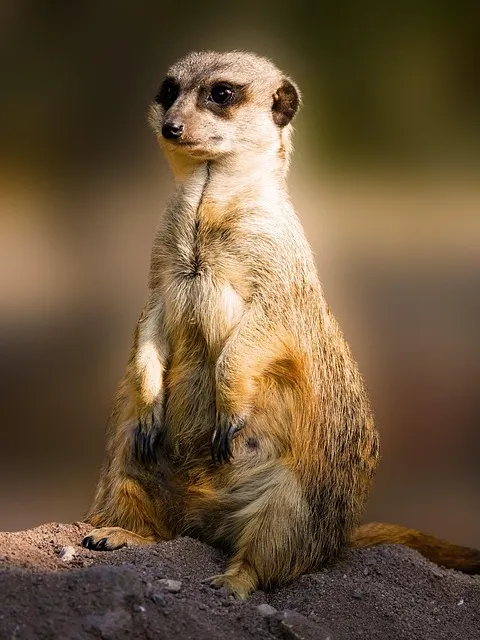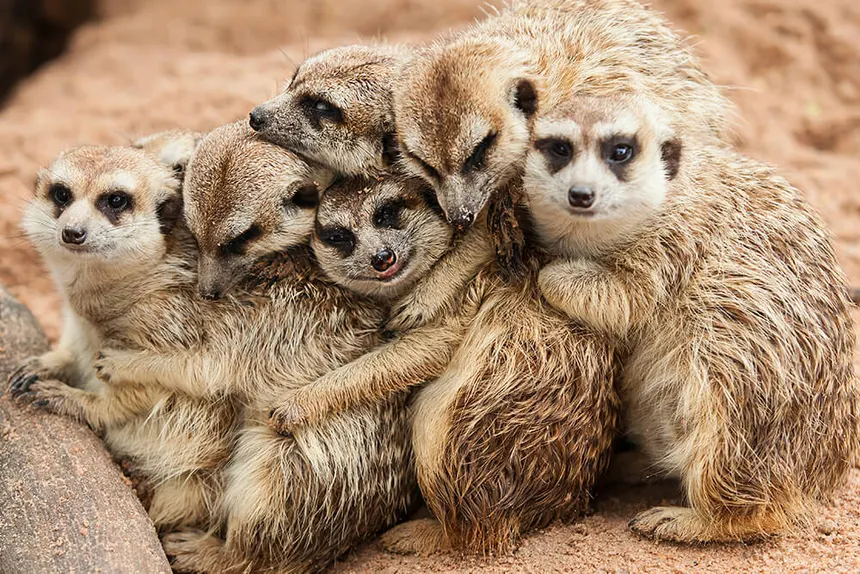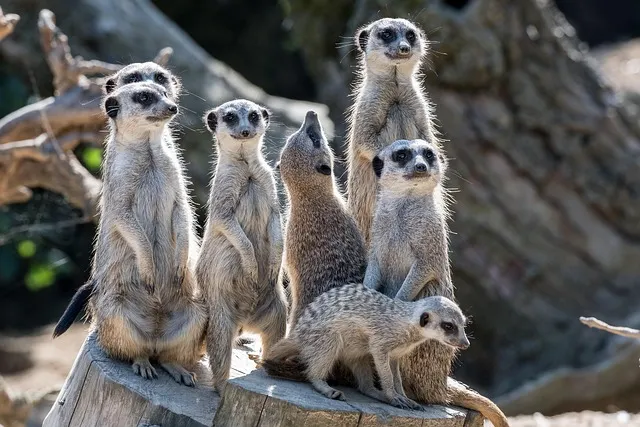Marvels of the Meerkat: Secrets of the Desert’s Most Social Survivor”

Meerkats (Suricata suricatta) are small, sociable mammals that live in the arid regions of southern Africa, especially in Botswana, Namibia, Angola, and South Africa. Known for standing upright on their hind legs and their cooperative family dynamics, meerkats are among the most fascinating members of the mongoose family. This article explores everything about meerkats—from their diet and social behavior to surprising facts about their intelligence and survival skills.
Scientific Classification
- Kingdom: Animalia
- Phylum: Chordata
- Class: Mammalia
- Order: Carnivora
- Family: Herpestidae
- Genus: Suricata
- Species: S. suricatta
- Common Name: Meerkat
Physical Description
- Size: About 9.8 to 11.8 inches (25–30 cm) long with a tail adding another 7.5 to 9.8 inches (19–25 cm)
- Weight: 1.4 to 2.1 pounds (0.6–1 kg)
- Color: Sandy brown with lighter underbellies and dark eye patches
- Notable Features: Long claws for digging, slender body, and an upright stance for scouting
Habitat
Meerkats live in open plains, grasslands, and deserts, particularly in areas with loose, sandy soil where they can dig complex burrow systems. These burrows help them escape the intense heat, predators, and cold desert nights.
Social Behavior and Structure
- Highly Social: Meerkats live in groups called “mobs,” “gangs,” or “clans” that consist of up to 30 individuals.
- Cooperative Living: They share responsibilities, including babysitting pups, foraging for food, and standing guard.
- Matriarchal Society: Usually, a dominant female leads the group and is often the only one to breed.
- Sentinels: One meerkat always stands guard on a rock or mound to watch for predators, warning the group with distinct alarm calls.
Diet and Foraging
- Omnivorous: Meerkats eat a variety of insects, small reptiles, amphibians, scorpions, eggs, plants, roots, and fruit.
- Scorpion Hunters: They are immune to certain venoms and can eat scorpions after removing the stinger.
- Excellent Foragers: They use their keen sense of smell and strong claws to dig for prey hidden underground.

Communication
Meerkats are highly vocal, using a range of sounds for:
- Warnings (predators nearby)
- Location (keeping track of group members)
- Mood (distress, contentment, aggression)
Each sound has a different pitch, rhythm, and meaning, and they can even differentiate types of threats, such as aerial vs. ground predators.
Breeding and Reproduction
- Mating Season: Year-round, but more frequent during rainy seasons.
- Gestation: About 11 weeks
- Litter Size: 2–5 pups
- Care: Pups are raised communally, with non-breeding adults acting as babysitters and teachers.
- Development: Pups begin foraging with adults by 3 weeks of age.
Predators and Threats
Common predators include:
- Birds of prey (e.g., eagles and hawks)
- Snakes
- Jackals and wild cats
Their main defense is vigilance and teamwork—they rely on early warning systems and burrow escapes.
Amazing Facts About Meerkats
- Immune to Some Venoms: Meerkats can survive scorpion stings and even eat them.
- They Can Close Their Ears While Digging: This keeps out sand while they excavate.
- Eyes Are Built for Scouting: Dark rings around their eyes reduce sun glare, enhancing long-distance vision.
- They “Teach” Their Young: Adults gradually train pups by giving them injured prey to practice on.
- Burrows Can Be Massive: Meerkat burrow systems can have up to 90 entrances and extend over several meters underground.
- Stand Like Little Soldiers: Meerkats are famous for standing upright on their hind legs to survey their surroundings.
- Excellent Memory: They can remember predator calls, foraging routes, and even social ranks.
- Adopt Orphans: Sometimes, orphaned pups are adopted by other clan members.
- They Live in Harsh Climates: Despite the intense sun and scarcity of food, meerkats are highly adaptable desert survivors.
- Lifespan: In the wild, meerkats live around 6–8 years, but in captivity, they can live up to 12–14 years.
Conservation Status
- IUCN Status: Least Concern
- Threats: Habitat loss, drought, and human expansion
- Protection: They live in many protected areas and benefit from conservation awareness programs.
Cultural Significance
Meerkats gained fame from documentaries like Meerkat Manor and animated movies (The Lion King’s Timon character). They’re often used to symbolize vigilance, teamwork, and cleverness.

Conclusion
Meerkats are far more than just cute desert dwellers. Their social intelligence, survival instincts, and fascinating behaviors make them one of nature’s most captivating creatures. Whether they’re digging tunnels, keeping watch, or teaching their young, meerkats live in a tight-knit society where every member plays a part—a powerful example of how cooperation ensures survival in the wild.



